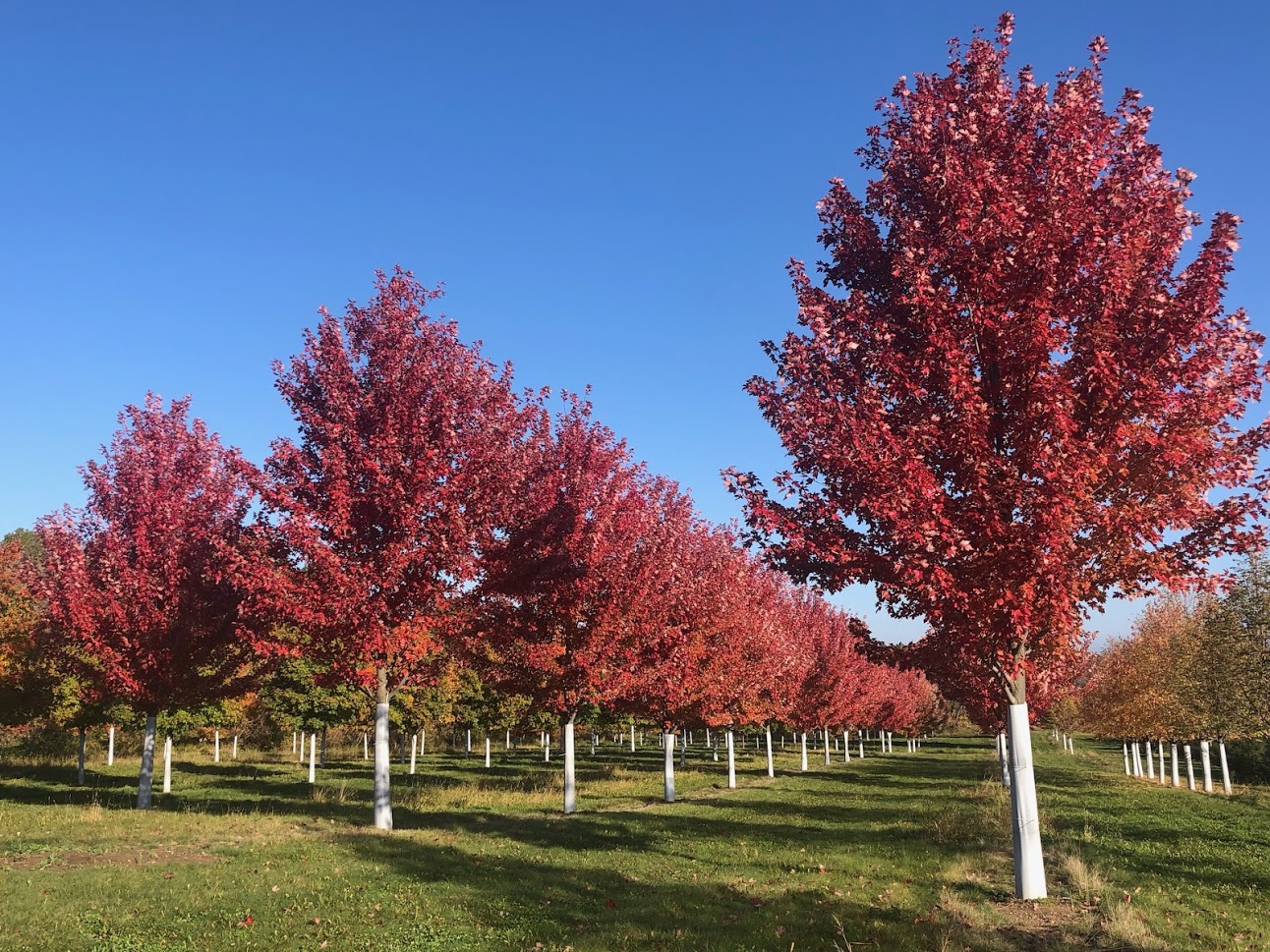As the hues of autumn leaves begin settling into the landscape, the cooler months signal an ideal time to plant new trees. With the intense heat of summer fading, trees can focus on establishing robust root systems without the added stress of high temperatures. This period offers a significant advantage, especially for mature trees that require extra care to acclimate to their new environment. Drawing on decades of experience in large tree relocation, Environmental Design Inc. provides comprehensive guidance to ensure newly planted trees thrive during this season.
Understanding the Benefits of Fall Planting
Planting trees in the fall presents several benefits over other seasons. Cooler temperatures reduce transpiration, meaning trees lose less water through their leaves and experience less stress. The soil remains warm even as air temperatures drop, promoting root growth and establishment. Additionally, pests and diseases are less active during this time, allowing trees to settle without significant threats. Increased rainfall and lower evaporation rates provide consistent soil moisture, giving trees the hydration they need without the risk of overwatering. Moreover, trees have time to establish roots during dormancy, leading to vigorous growth in the spring.
Selecting the Right Trees for Fall Planting
Choosing the appropriate tree species is crucial for successful planting in the fall. Certain species respond particularly well to being introduced during cooler months due to their root growth patterns and hardiness. Deciduous trees like maples, oaks, elms, and birches are excellent choices. For instance, red maples and sugar maples are renowned for their vibrant fall colors and establish roots effectively in the cooler months. Oaks such as red oak and white oak benefit from fall planting due to their deep root systems. Evergreens like Eastern white pine and Colorado blue spruce can also be planted in early fall, allowing them to acclimate before winter sets in.
When selecting a tree, consider factors such as climate compatibility to ensure the species is suitable for your USDA hardiness zone. Match the tree’s soil preferences with your site conditions, taking into account the pH level and soil texture. It’s important to consider the mature size and shape of the tree to ensure adequate space and to prevent future conflicts with structures or other plants. Define the purpose of the tree—whether for shade, ornamental value, screening, or wildlife support—to choose a species that meets your specific needs.
Assessing and Preparing the Planting Site
A thorough site assessment is essential for the tree’s long-term health. Observe the site’s sunlight exposure throughout the day to match the tree’s light requirements. Evaluate soil drainage by performing a percolation test: dig a hole, fill it with water, and time how long it takes to drain. Good drainage is crucial to prevent root rot. Check for underground utilities by contacting local services before digging, and ensure the tree will not interfere with buildings, power lines, or pavement as it grows.
Conducting a soil test will determine pH levels, nutrient content, and soil texture. Most trees prefer a pH between 6.0 and 7.0. Knowing the soil’s nutrient content helps identify deficiencies in nitrogen, phosphorus, potassium, and micronutrients, which can be addressed with soil amendments. Understanding whether the soil is sandy, loamy, or clayey will inform your watering practices and may influence the choice of tree species.
Preparing the planting site involves clearing vegetation such as grass and weeds in a three-foot diameter around the intended planting hole to reduce competition for nutrients and water. Dig the planting hole two to three times wider than the root ball and equal in depth to prevent settling. Incorporate organic matter like compost to improve soil structure, but avoid excessive amendments that could create a soil environment discouraging root expansion beyond the planting hole.
When planting the tree, handle it carefully to avoid damaging the roots. Place the tree in the hole with the root flare at ground level—the point where the roots spread at the base of the trunk. Rotate the tree for the best appearance if it has a preferred side. Backfill the hole with native soil, breaking up clumps and eliminating air pockets by gently firming the soil. Water thoroughly after planting to settle the soil around the roots and to provide essential moisture.
Immediate Post-Planting Care
Proper watering is critical for the tree’s establishment. After planting, water deeply to saturate the root zone. For the first two weeks, water every two to three days to maintain consistent moisture. From weeks three to twelve, reduce watering to once a week, depending on rainfall and soil moisture levels. Apply enough water to reach 12 to 18 inches deep, encouraging deep root growth. Adjust the watering schedule based on weather conditions, increasing frequency during dry spells and reducing it after significant rainfall. Signs of proper watering include healthy, vibrant leaves without wilting and slightly damp soil at root level.
Mulching is another essential step in post-planting care. Apply a layer of organic mulch, such as hardwood chips, pine straw, or shredded bark, around the base of the tree. Mulch helps conserve moisture, regulate soil temperature, suppress weeds, and improve soil fertility as it decomposes. Spread the mulch in a doughnut shape, avoiding piling it against the trunk to prevent rot and pest infestation. Maintain a mulch layer two to four inches deep, and extend it to cover the area under the tree’s canopy or at least a three-foot radius around the trunk.
Young trees may require staking to withstand strong winds, especially in exposed areas. Use flexible ties to secure the tree to two or three stakes placed outside the root ball area, allowing slight movement to promote trunk strength. Ensure the ties do not damage the bark by using soft materials like arbor tie or canvas straps. Remove the stakes after one growing season to prevent girdling and encourage the tree to stand independently.
Long-Term Care Through Winter and Early Spring
Protecting newly planted trees during winter is crucial for their survival. Refresh the mulch layer to insulate the roots against temperature extremes. For broadleaf evergreens, consider applying antidesiccant sprays to reduce moisture loss through the leaves. Use physical barriers like burlap screens or windbreaks to shield the tree from harsh winds and sunscald. Wrapping young tree trunks with tree guards can prevent frost cracks caused by fluctuating temperatures. Be cautious with snow accumulation; gently brush off heavy snow to prevent limb breakage, but avoid shaking the branches, which can cause more harm.
Monitor the tree for signs of pests and diseases, even during winter. Regular inspections can help detect issues early. Look for indications of pests like scale insects or borers, and check for fungal growths or cankers on the trunk and branches. Remove any fallen leaves or debris that may harbor pathogens, and prune out diseased branches during the tree’s dormant period. However, avoid heavy pruning in the fall, as this can stimulate new growth that is vulnerable to winter damage.
As spring approaches, prepare the tree for the growing season. Conduct a soil test to determine any nutrient needs after winter. If necessary, apply a balanced, slow-release fertilizer when new growth begins, following the recommendations from the soil test results. Avoid over-fertilization, which can lead to excessive, weak growth susceptible to pests and breakage. Prune the tree in late winter or early spring before bud break to remove dead, damaged, or crossing branches and to shape the tree for desired structure. Use clean, sharp tools to make precise cuts just outside the branch collar, avoiding stubs or flush cuts that can hinder healing.
Ongoing Care Tips
Continued watering is essential as the tree matures. Gradually reduce the frequency of watering, but ensure deep watering to encourage the roots to grow downward and spread. During dry periods, even established trees may require supplemental watering to maintain health. Consider installing drip irrigation systems for efficient water use and to provide consistent moisture directly to the root zone.
Maintain soil fertility by top-dressing with compost annually and allowing organic mulches to decompose naturally. This practice adds essential nutrients to the soil and improves its structure, enhancing root growth and overall tree health. Avoid excessive use of synthetic fertilizers, which can lead to nutrient imbalances and environmental issues.
Healthy trees are better equipped to resist pests and diseases. Implement integrated pest management (IPM) practices by promoting cultural controls like selecting disease-resistant varieties and maintaining proper spacing for air circulation. Encourage beneficial insects such as ladybugs and predatory wasps to help control pest populations naturally. Regularly inspect the tree for signs of pests or diseases, and address any issues promptly. Use chemical controls sparingly and responsibly, following label instructions to minimize environmental impact and avoid harming non-target organisms.
Guiding the tree’s development through structural support and pruning is vital for long-term stability and aesthetics. Focus on developing a strong central leader by removing competing leaders and weak crotches during the tree’s early years. This practice encourages a sturdy structure that can withstand environmental stresses. For mature trees with structural weaknesses or heavy limbs, consult a professional arborist about cabling and bracing options to provide additional support without compromising the tree’s health.
Environmental Considerations
Adopting water-wise practices is important for sustainability and resource conservation. Select drought-tolerant species native to your region, as they typically require less water once established and are adapted to local conditions. Maintain mulch layers to reduce evaporation from the soil surface, conserving moisture. Water during cooler parts of the day, such as early morning or late evening, to minimize loss due to evaporation. Collect rainwater in barrels for irrigation when possible, reducing reliance on municipal water supplies.
Enhance the environmental benefits of your landscape by promoting biodiversity. Incorporate a variety of plant species, including understorey shrubs and groundcovers, to create layered habitats that support a wide range of wildlife. Choose trees that provide food and shelter for birds, pollinators, and other beneficial organisms. Installing birdhouses, bat boxes, or bee hotels can encourage wildlife to take up residence in your garden, contributing to a healthy ecosystem.
Conclusion
Planting trees during the cooler months is a strategic decision that offers numerous benefits. By carefully selecting suitable species, thoroughly preparing the planting site, and committing to diligent care through winter and into spring, newly introduced trees can establish strong roots and adapt to their environment effectively. This proactive approach results in healthier trees that contribute beauty, shade, and ecological value to your landscape for years to come.
Investing time and effort in proper tree care not only enhances your property but also supports broader environmental health. Trees play a crucial role in carbon sequestration, air purification, and providing habitats for wildlife. By following these guidelines, you can make a positive impact on your surroundings and enjoy the rewards of a thriving, vibrant landscape.
Environmental Design Inc.
With over 45 years of experience, Environmental Design Inc. is committed to excellence in tree care and planting. Our team of certified arborists and horticultural experts specializes in large tree relocation, site consultation, professional planting services, and customized aftercare programs. We are dedicated to promoting sustainable landscaping practices and providing our clients with the knowledge and support needed to care for their trees effectively. Need a quote on a project? Call us today.




Recent Comments